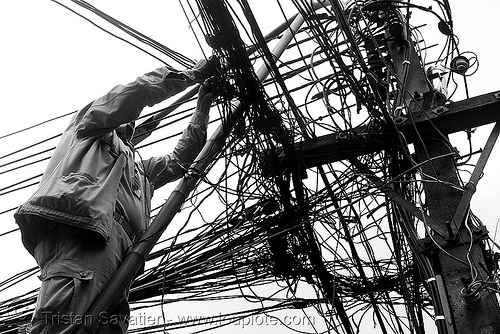An Italian researcher in telecommunications, Basilio Catania, and the Italian Society of Electrotechnics, "Federazione Italiana di Elettrotecnica", have devoted a Museum to Antonio Meucci, constructioning a chronology of his inventing the telephone and tracing the history of the two trials involving Meucci and Alexander Graham Bell
Both claim that Meucci was the real inventor of the telephone, but base their argument on the reconstruction rather than contemporary evidence. What follows, if not otherwise stated, is a résumé of their historic reconstruction.

In 1834 Meucci constructed a kind of acoustic telephone as a way to communicate between the stage and control room at the theatre "Teatro della Pergola" in Florence. This telephone is constructed on the model of pipe-telephones on ships and is still working.
In 1848 Meucci developed a popular method of using electric shocks to treat rheumatism. He used to give his patients two conductors linked to 60 Bunsen batteries and ending with a cork. He also kept two conductors linked to the same Bunsen batteries. He used to sit in his laboratory, while the Bunsen batteries were placed in a second room and his patients in a third room. In 1849 while providing a treatment to a patient with a 114V electrical discharge, in his laboratory Meucci heard his patient's scream through the piece of copper wire that was between them, from the conductors he was keeping near his ear. His intuition was that the "tongue" of copper wire was vibrating just like a leave of an electroscope; which means that there was an electrostatic effect. In order to continue the experiment without hurting his patient, Meucci covered the copper wire with a piece of paper. Through this device he heard inarticulated human voice. He called this device "telegrafo parlante" (litt. "talking telegraph").
On the basis of this prototype, Meucci worked on more than 30 kinds of sound transmitting devices inspired by the telegraph model as did other pioneers of the telephone, such as Charles Bourseul, Philipp Reis, Innocenzo Manzetti and others. Meucci later claimed that he did not think about transmitting voice by using the principle of the telegraph "make-and-break" method, but he looked for a "continuous" solution that did not interrupt the electric current.
In 1856 Meucci later claimed that he constructed the first electromagnetic telephone, made of an electromagnet with a nucleus in the shape of a horseshoe bat, a diaphragm of animal skin, stiffened with potassium dichromate and keeping a metal disk stuck in the middle. The instrument was hosted in a cylindrical carton box. He said he constructed this as a way to connect his second-floor bedroom to his basement laboratory, and thus communicate with his wife who was an invalid.
Meucci separated the two directions of transmission in order to eliminate the so-called "local effect", adopting what we would call today a 4-wire-circuit. He constructed a simple calling system with a telegraphic manipulator which short-circuited the instrument of the calling person, producing in the instrument of the called person a succession of impulses (clicks), much more intense than those of normal conversation. As he was aware that his device required a bigger band than a telegraph, he found some means to avoid the so-called "skin effect" through superficial treatment of the conductor or by acting on the material (copper instead of iron). He successfully used an insulated copper plait, thus anticipating the litz wire used by Nikola Tesla in RF coils.
In 1864 Meucci later claimed that he realized his "best device", using an iron diaphragm with optimized thickness and tightly clamped along its rim. The instrument was housed in a shaving-soap box, whose cover clamped the diaphragm.
In August 1870, Meucci later claimed that he obtained transmission of articulate human voice at a mile distance by using as a conductor a copper plait insulated by cotton. He called his device "teletrofono". According to an Affidavit of lawyer Michael Lemmi drawings and notes by Antonio Meucci dated September 27 1870 show coils of wire on long distance telephone lines. The painting made by Nestore Corradi in 1858 mentions the sentence "Electric current from the inductor pipe".